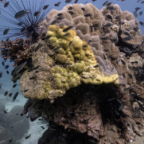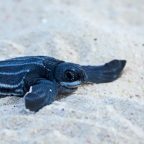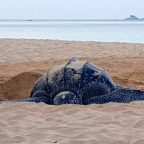
Each month, fishermen in the Gulf of Thailand risk their lives harvesting live sea snakes. It’s risky for both parties: the snakes are in danger of being over-harvested and the fishermen could get bitten. Scientists are now calling for a monitoring programme to assess the impact the on-going trade will have on their population numbers and to look how it affects the ecosystem. A team reports in the journal Conservation Biology that fishermen have noticed a decline in their population since 2009. The researchers now want to understand if this is due to overfishing or other factors like pollution.
The fishermen fish for squid with nets and hooks, and at the same time pick up hundreds of deadly sea snakes. The snakes have particularly potent venoms, which can be lethal. Most of the fishing occurs at night, in small boats with crews of seven to 25. They use the luminous light of electric lamps to attract the squids. These lights are also believed to appeal to the snakes, which are fished out of the water at the same time.
The trade has grown considerably. Around 20 years ago there were only 20-30 fishing vessels hunting for sea snakes. Today there are more like 700 and each year they bring in 80 tonnes of sea snakes. Over seven different species are routinely caught, but most of the catch is Hardwick’s sea snakes and black-banded sea snakes.
At shore the snakes are quickly weighed and sorted by size. A typical merchant can categorise 20-30 kg of snake in a few minutes. Given that a small snake weighs about 500g, they may sort through 60 live snakes in less than five minutes, using only their bare hands. They also sometimes walk barefoot in large basins full of live sea snakes.
Bites are an occupational hazard and there is a serious shortage of anti-venom in the region. If someone gets bitten, they quickly pierce their skin with a razor blade to extract the venom. People also treat bites with garlic and grated rhinoceros horn, which have no proven medical benefits. The economic benefit to the fishers and merchants “clearly outweighs” the risk of being bitten, says Zoltan Takacs of the National Geographic Society and co-author of the new paper. His team saw seven bites during two trading sessions, though no one was killed.
No part of the snake goes to waste. It is consumed as food, drink or medicine elsewhere in Asia, often exported to China and Vietnam. Snake meat is a delicacy. It can be fried or eaten in soups, and the heart and liver are considered beneficial to pregnant women.
Sometimes snake is submerged in rice wine and served as a drink. The blood can also be mixed with alcohol. People believe it brings them health benefits. People also make “sea snake glue”, which is marketed as curing a range of conditions including joint and back pain, insomnia and anorexia.
Takacs’ team is worried that over-harvesting could deplete the populations of some species. “We have no idea of the true magnitude of the damage the [fishing] may have on snakes and the ecosystem of the Gulf of Thailand,” says Takacs.















Social Profiles